The past century has witnessed many excavations
at Antelope Creek sites and a much smaller number of substantial
published results. Archeologists now have a fairly good grasp of
the "material signature" of Antelope Creek culture—the characteristic
architectural patterns, artifacts, and ecofacts (animal bones and
such). And we have begun to understand the geographic extent and
variation of Antelope Creek and related Plains Village cultures
in the region. But what we know pales by comparison to what archeologists
could and, frankly, should know by now.
Consider, for example, that as of 2004 fewer than
a half a dozen published reports have described, counted, illustrated,
measured, and identified source material for the stone tools and
pottery fragments recovered from a specific excavation at an Antelope
Creek site. Such technical details may seem mundane and even boring
to the general reader, but they are the critical building blocks
upon which any archeological scholar must depend. Good science demands
good data, good published data.
Improved understandings of the Plains villagers
of the Texas Panhandle will require a lot more of what is known
in other fields as "basic research." We do not
mean simply "more digging," we mean a lot more top-notch
research, in the field and the laboratory. Research carried out
by thoughtful design and research that is carried through to proper
completion including full reporting of all the technical details.
A Dozen Antelope Creek Research Problems
While dozens and dozens of basic
research needs, large and small, could and should be spelled out
and pursued, listed below are a dozen worthy research problems and
needs as identified by archeologists Chris Lintz, Doug Boyd, and
Scott Brosowske. The first four items are very basic research needs
upon which almost all interpretations of Antelope Creek culture
rely.
(1) Dating. We still need many more radiocarbon
dates from Antelope Creek sites to refine our understanding of the
origins, development, and demise of Plains Village life in the Texas
Panhandle. Lintz and others have put forth some intriguing arguments,
but most of these cannot be properly evaluated without more rigorous
sets of dates from a variety of sites, contexts, and settings.
While radiocarbon is the most widely accepted and
commonly used dating method, other useful techniques have been around
for awhile (such as archeomagnetic dating, thermoluminescence, and
obsidian hydration dating), and there are some new promising techniques
on the horizon. For instance, optically stimulated luminescence
measures the elapsed time that the quartz particles within buried
sand deposits were last exposed to sunlight and the technique could
be a particularly important tool in future archeological studies
in the region.
(2) Paleoenvironment. The past climatic history
of the Texas Panhandle before, during, and after the Plains Village
era remains imprecisely understood. While much has been made of
the apparent onset of drought conditions around A.D. 1250 and the
increasingly inhospitable conditions for the next 150-200 years,
our interpretations are based largely on extrapolations of climatic
data from neighboring regions. We need better paleoclimatic data
from the heartland of Antelope Creek culture.
(3) Economy. We still have a very inadequate
understanding of how Antelope Creek people supported themselves.
Until recently, domesticated crops (including corn, beans, and squash)
were generally assumed to have supplied most of the food upon which
Antelope Creek people depended. This assumption seems at odds with
the argument that the region experienced worsening drought conditions
during Antelope Creek days. Studies of animal bones indicate that
a wide range of species large and small were hunted, trapped, bopped,
and netted. Even so, at some sites almost 90% of the bone was broken
and reduced into unidentifiable fragments. This pattern is consistent
with the systematic extraction of bone grease and marrow, a practice
suggesting that every bit of food value was being removed from the
animal bones. Recent technological studies of ground stone manos
as well as isotopic chemical studies of human bones suggest that
horticulture (early agriculture) may have played a relatively minor
role in food acquisition.
The idea that Antelope Creek people may have been
mainly gatherers and hunters who supplemented their diets with planted
crops does not seem consistent with the considerable evidence that
they were semi-sedentary (living in one place) for much of the year.
This suggests that Antelope Creek culture would make a most interesting
case study in Late Prehistoric survival strategies, but this will
require many more well-dated samples of plant and animal remains
from a variety of sites. The use of typical ¼-inch mesh sifting
screens, while a standard recovery practice in archeology, rarely
yields the tiny, but highly informative, pieces of charred plants
and small animal bones. It is imperative that all future excavations
take sediment samples and process them using the flotation technique
to increase the recovery of this important evidence.
(4) Tool Function. Detailed studies of the manufacturing, use, and
life cycles of the stone and bone tools used by Antelope Creek villagers
are needed. Even though archeologists routinely speculate about
the function of such tools based on their general form, detailed
studies elsewhere in the world suggest that the actual functional
uses of such tools are more complicated and meaningful. The same
is doubtlessly true for Antelope Creek. For instance, Marie Huhnke's
recent study of buffalo scapula (shoulder blade) implements from
Alibates 28 suggests that most were not suited to be used as agricultural
hoe blades, as previously assumed. Instead she postulates that scapula
tools probably served mainly as trowels for mixing and applying
mortar and plaster during house construction and maintenance. Many
such thoughtful analyses are needed to give us behavioural insights
into Antelope Creek life.
(5) Architectural Patterns. Settlements in the eastern Texas Panhandle,
particularly east and south of the Canadian River, seem to have
houses that lack stone foundations in favor of picket-post walls,
but yet they have the central channels, central hearths, "altars,"
and other floor features found in classic Antelope Creek houses.
What accounts for these architectural differences? Are they merely
reflections of local conditions and available building materials
or are they indications of distinct cultural groups, such as the
one apparently represented by the Zimms complex of western Oklahoma?
We generally know very little about what the superstructural
(above-ground) portions of the classic Antelope Creek houses looked
like. Some researchers, for example, feel these houses were more
like Plains earthlodges than Southwestern-style pithouses. Accurate
reconstructions of what prehistoric houses were really like must
be based on many lines of evidence, such as thoughtful analysis
of very detailed excavation data, special emphasis on understanding
post-depositional processes (what happens to a prehistoric house
once it is abandoned and buried), and even experimental archeology
aimed at replicating such houses.
(6) Settlement Zones. Antelope Creek settlements do not occur uniformly
across the region. For instance, in the vicinity of Palo Duro Reservoir,
west of the Buried City area and between the Canadian and North
Canadian rivers, there are very few typical Antelope Creek stone
slab houses. Was this a "no-man's land," a buffer zone
between major settlement zones, or simply a place were houses were
built with picket-post walls rather than with rock foundations?
More generally, how do we explain the distinct geographic clusters
of Antelope Creek sites?
(7) Field Huts or Guest Houses? The 1962 excavations
at the Conner site and several others in the Lake Meredith area
exposed small circular structures that were associated with relatively
few artifacts and a disproportionately high number of buffalo limb
elements (leg and foot bones) from only one side of the animal.
This pattern prompted Lathel Duffield to postulate that these may
have been seasonal field huts where villagers stayed while away
from their main homesteads and hamlets. (The bone pattern suggested
organized food sharing whereby family groups may have divided up
carcasses into equal portions.) Yet, recent studies of similar,
small circular structures at the Roper and Chicken Creek sites reveal
very robust assemblages of artifacts and bones rivaling those found
at any hamlet (i.e., a typical Antelope Creek “village”).
Are these smallish sites with circular structures
really clusters of seasonally occupied field huts or could they
be areas where visiting Plains Village groups stayed while they
traded for Alibates flint? In this model, the large, typical Antelope
Creek houses were home to the resident villagers who controlled
access to the flint quarries, while visitors lived in modest, temporary
quarters. Other possibilities exist, a fact that underscores the
need for more detailed analyses of Antelope Creek structures and
their associated debris.
(8) Landergin Mesa Refuge? Lintz estimates that there may have been
as many as 95 isolated homestead-type structures built within the
half-acre top of Landergin Mesa and that these houses were built
over the duration of the Antelope Creek phase. This finding contradicts
his earlier notion that during early Antelope Creek days (which
he called the “subhomestead period”), houses were clustered
into room blocks, especially in a locality that has obvious, severe
spatial limitations. Why does the settlement pattern atop mesa sites
differ from the pattern identified around the Alibates quarries
(i.e., at Antelope Creek 22 and Alibates 28)? Was Landergin Mesa
used as a temporary refuge that was occupied for such brief periods
that contiguous structures (pueblo-like room blocks) never evolved?
(9) Antelope Creek Rock Art. Systematic archeological surveys (uniform,
thorough coverage of sizable areas) have taken place in the Antelope
Creek region only very recently (since the late 1990s). As a result,
some new site density and distribution patterns are being seen.
For instance, studies of the burned-off areas at the Alibates National
Flint Quarries have found numerous examples of rock art in apparent
association with Antelope Creek habitation sites. The rock art in
question presumably consists mainly of boulders with petroglyphs
(pecked designs) or “cupules" (cup-shaped pecked areas).
Better known petroglyph designs thought to be associated with Antelope
Creek culture include footprints and turtles. Some have also argued
that certain pictographs (painted designs) were created by Antelope
Creek artists, but pictographs are rare in the Texas Panhandle.
We are a long way from understanding which designs (if any) were
actually executed by Antelope Creek peoples. Thorough documentation,
dating, and analysis of such rock art sites might reveal common
design patterns that tell us something about Antelope Creek symbolic
and ritual life.
(10) Agricultural Technology. What particular methods were used
to grow corn, beans, and squash? Where, specifically, were most
of the agricultural fields situated relative to Antelope Creek villages?
Did they plant fields in the middle of the floodplains and hope
the floods would spare the crops? Or were the main fields on top
of the first major terraces above the floodplains? Where appropriate,
were crops planted adjacent to sand dunes to take advantage of the
water that drains from the base of saturated dunes? Or perhaps fields
were planted below steep slopes in places where run-off water could
be diverted to specific fields? While it is almost certainly the
case that various planting strategies were employed, the ancient
agricultural technology of the region has received precious little
careful study.
(11) Plains Villager Interactions.The distinct marine shell and
turquoise jewelry, obsidian, and painted ceramic vessels made by,
or at least obtained from, Southwestern groups are relatively easy
to recognize as non-indigenous (foreign) trade goods in Antelope
Creek sites. It is much more difficult to discern the trade items
obtained from other Plains Village groups in the Southern and Central
Plains, groups who made similar kinds of pottery and used similar
kinds of stone resources. Difficult, but not impossible. Detailed
studies are needed of the pottery paste characteristics and raw
material sources (based on trace elements) of sizable samples of
cordmarked pottery before we can really understand the nature of
Plains Village interactions.
(12) Cultural Identity and Conflict. Who were
the Antelope Creek peoples, who were they most closely related to,
and who were their enemies? In a recent summary of Antelope Creek
culture, Oklahoma state archeologist Robert Brooks wrote that, “Much
of the Antelope Creek mystique is linked to the biological characteristics
of the population. While study of this area is clouded by the propriety
of examining human remains, for tribes as well as archeologists,
systematic evaluation of the biological nature of these groups is
critical to our understanding of the origin and ultimate destination
of the group and its culture.” Many questions about the ethnic
identities of Antelope Creek and other Plains Village peoples can
be addressed using modern scientific techniques such as DNA studies
and craniometric (skull measurement) data analysis. Furthermore,
other innovative techniques such as a bone chemistry study called
isotope analysis can provide direct evidence on human diet that
can be used to define a group’s economy and cultural identity.
The trophy skulls at the Footprint site and the finding of numerous
burials with evidence of violence (such as embedded arrow points)
in the Texas Panhandle and western Oklahoma demonstrate that considerable
hostility took place in Antelope Creek times. But who was fighting
whom? Were Antelope Creek villagers fighting each other? Or was
it raids by competing villagers from elsewhere in the Southern Plains?
Perhaps, late in Antelope Creek times, it was mainly non-villager
Athabascan-speaking intruders (ancestors of the Apache peoples)
from the northwest. Was the violence simply an inevitable consequence
of unstable “trade and raid” relationships with Puebloan
peoples of the Southwest? It seems quite likely that conflicts occurred
between and among various groups in the region for various reasons,
but we are a long way from understanding even the broad outlines
of what happened.
Although it is not always a pleasant topic of discussion,
prehistoric warfare may have had a huge impact on the lives of various
prehistoric groups in and around the Southern Plains. In his book
Prehistoric Warfare in the American Southwest, Steven LeBlanc
put it succinctly when he said of warfare: "It cannot be ignored
or relegated to a footnote, if the past is to be understood."
Preserving the Past for the Future
Antelope Creek architectural remains tend to
stick up like an unnaturally square thumb on the landscape of the
Texas Panhandle. As a result, most sites in the Canadian River Valley
have been vandalized, some much worse than others. For every Antelope
Creek house that archeologists have excavated, 10 or 20 others have
been dug into or completely destroyed by others. Explorers,
treasure hunters, pothunters, and curiousity seekers have all dug
up Antelope Creek houses and most were disappointed by what they
found. The combined forces of progress, housing development, and
commerce have also taken their inevitable toll and torn asunder
many ancient settlement areas.
Even so, many traces of Antelope Creek life yet remain;
if not untouched, they are at least recognizable and capable of
yielding telltale scientific clues about the human past. But today's
archeologists can only do so much. Even if we had unlimited time
and funding, we know that the archeologists of the future will have
analytical tools and research goals we never dreamed of. By modern
standards, most of Floyd Studer's archeological field techniques
were crude and not very scientifically productive, and we can be
sure that archeologists 50 years from now will look back at us with
equal disappointment. From the archeological perspective, that is
why preserving/conserving ancient sites and ancient landscapes by
leaving them intact and undisturbed is a worthy and ethical goal.
There is another, more important consideration. If
those of us living in the early 21st century don't make concerted
efforts to preserve important archeological sites, future generations
may not consider us too kindly. Every generation of Panhandle residents
looks across the landscape, flatlands and breaks alike, with wonder.
How did those who came before us survive and even thrive
for so many generations? The story of the Antelope Creek
culture isn't entirely lost and we owe it to our great grandchildren
to learn what we can about our human ancestors and predecessors
and to do that we must preserve meaningful traces of past for the
future.
|
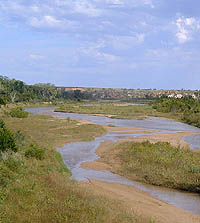
The Canadian River Valley in the eastern
Texas Panhandle was apparently settled sparsely by Plains
Villagers compared to the core Antelope Creek area to the
west farther upstream. This impression may not be entirely
accurate as the area has seen few systematic archeological
surveys. Photo taken in Roberts County by Steve Black.
Click images to enlarge
|
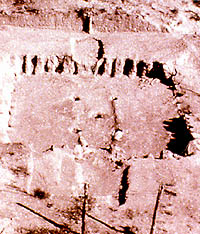
A pithouse excavated at the Jack Allen
site in 1969-70 had picket-post walls and lacked the stone-slab
wall foundations found in most Antelope Creek houses. Picket-post
walls are more common in the eastern Texas Panhandle and in
western Oklahoma but it is not yet known whether they reflect
a construction technique preferred by non-Antelope Creek peoples
or perhaps a relatively early stage in the evolution of building
techniques in the region. Sorting out the meaning of such
patterns will require a larger sample of well-dated and carefully
described houses. Photo courtesy Chris Lintz. |
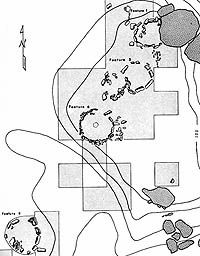
Plan map of the Roper site showing four
small circular structures that could represent seasonal field
huts or some other kind of temporary houses. From Duffield
1970. |
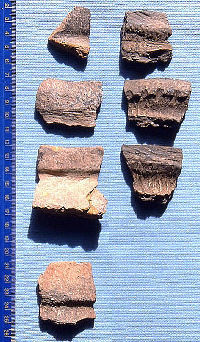
The finding of a few pottery sherds with
"collared" (thickened) rims at several Antelope
Creek sites was interpreted by Jack Hughes as possible evidence
of trade and interaction with Plains Villagers from the Central
Plains. This photo compares the four known collared rim sherds
from Antelope Creek sites with three Nebraska phase sherds
from the Central Plains. While the rims look somewhat similar,
technical studies of the paste suggest the Antelope Creek
collared-rim pottery was made locally. (On the left, the bottom
sherd is from the Cottonwood Creek site, while the other three
are from the Roper site.) Photo by Chris Lintz. |
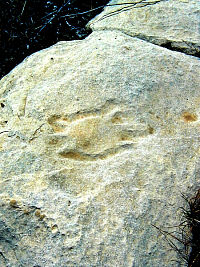
This well-known petroglyph (pecked design)
at Alibates Ruin 28 depicts a turtle. Recent surveys suggest
that petroglyphs may be commonly associated with Antelope
Creek ruins. Thorough documentation, dating, and analysis
of such rock art sites might reveal common design patterns
that tell us something about the symbolic and ritual life
of Antelope Creek villagers. Photo by Steve Black. |
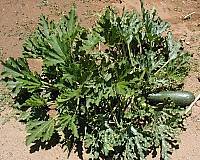
Squash growing in an experimental garden
in the American Southwest. It is not known whether Antelope
Creek people grew much squash or, if they did, where their
squash fields were situated. Much remains to be learned about
the Antelope Creek economy. Photo by Steve Black. |
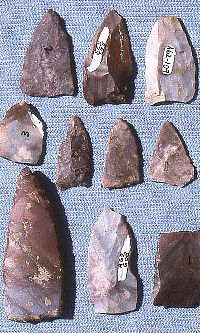
These "guitar pick" scrapers
(unifaces) from the Roper site are a common occurrence on
some Antelope Creek sites. (The name comes from their suggestive
shape.) Although it is assumed they were used as hide scrapers,
there are other uniface forms present and the guitar pick
scrapers may have had a specialized function. Photo by Chris
Lintz. |
|
Much of the Antelope Creek
mystique is linked to the biological characteristics of the
population. While study of this area is clouded by the propriety
of examining human remains, for tribes as well as archeologists,
systematic evaluation of the biological nature of these groups
is critical to our understanding of the origin and ultimate
destination of the group and its culture.
-- Brooks 2004, p. 334 |
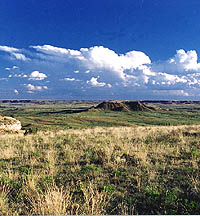
Portions of the Canadian River Valley
in the Texas Panhandle remain remote and undeveloped. Photo
by Kris Erickson. |
|